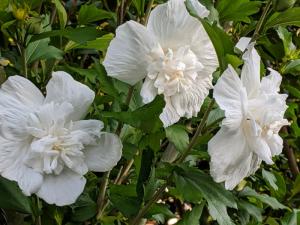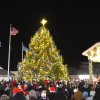The whole world loves hibiscus.
The gorgeous flowers can be very big, eight inches across or more. Longwood Gardens has a greenhouse full of them.
This region has many ornamental native hibiscus. They are available as shrubs or perennial plants, all with large, colorful flowers that can dazzle a garden with tropical splendor in summer. While they have no fragrance, they attract both hummingbirds and butterflies. Monarchs especially love them.
All these types of hibiscus can be seen, most at their peak of bloom, at Mill Pond Garden, 31401 Melloy Court, Lewes, during its open garden day from 10 a.m. to 1 p.m., Sunday, July 26, rain or shine.
To subscribe for invitations to request tickets, or to buy a ticket, go to www.millpondgarden.com. A horticulturist will be on duty to answer questions. Visitation is very limited and in assigned time segments for safety. All state safety procedures are observed with masks and distancing for visitors and staff.
“Hibiscus is a genus of flowering plants in the mallow family (malvaceae), including hundreds of species that are native worldwide in temperate and tropical areas,” said Michael Zajic, horticultural director of Mill Pond Garden. “Here on Cape Henlopen we have hibiscus moscheutos, common name crimson-eyed rose-mallow, or marshmallow hibiscus, a perennial growing often in wet soils of marshes, seen commonly in roadside ditches in Delaware. The hybrids of this native species are popular garden plants, with good reason. They bloom from mid-July to mid-September. Also grown here at Mill Pond Garden, but seen rarely, is another native, hibiscus coccineus, the scarlet rose mallow, a hardy hibiscus species that looks much like cannabis sativa, growing to seven feet tall. It blooms from late July to mid-October. The plant is found in swamps, marshes and ditches on the coastal plain of the southeastern United States.”
Other hibiscus grown in Cape gardens since the 19th century include the hardy woody shrub hibiscus syriacus, common names rose of Sharon or althea, which blooms in white, red, blue, pink and purple. Althea are invasive and need to be checked for unwanted spread, but they bloom from midsummer to early fall. If a gardener deadheads (removes the spent flowers before they grow seed pods), the invasive issue can be prevented.
Shrub althea is best planted in rich, slightly acidic soil with good drainage, in full sun to part shade. The rose of Sharon bush will tolerate most soil conditions except soggy wet or extremely dry. They can be pruned to any size desired, anytime in winter. The heaviest flowering occurs if dormant stem tips are pruned back about two feet. If this pruning is done after frost bares the stems, as recommended by Mill Pond Gardens, the seed pods and invasive reproduction can be controlled at the same time.
Some gardeners enjoy the tropical hibiscus, hibiscus rosa-sinensis, known as Chinese hibiscus, China rose, Hawaiian hibiscus or rose mallow. This show-stopper adds big, brilliant flowers in many colors and combinations. They do well in pots or in the ground, and look great on a patio or at an entrance. All these shrub, perennial native and tropical hibiscus are now at or near peak bloom, and they are available from most local nurseries. Some even have red foliage.
Mill Pond Garden recommends feeding all these hibiscus in early spring and again in early summer with a balanced organic fertilizer with trace elements, neutral pH and some powdered kelp for maximum flowering. A good choice would be Plant Tone by Espoma, available everywhere, but add one’s own kelp and a bit of epsom salts separately to the mix, about two tablespoons of each to a gallon volume of granular organic fertilizer. Avoid chemical fertilizers with too much nitrogen, or the hibiscus plant gets too leggy, with too many leaves and fewer blooms. Hardy hibiscus can be planted any time of year they are available. The tropical hibiscus can sometimes be wintered over in a sunny window in a garage, but the results are not reliable. Mill Pond Garden recommends throwing them out when frost kills them and buying a new plant in spring. Get big ones for happy results.
Gardeners believe in a future. That belief needs cultivation now. Joy grows like a flower; make it grow with a splendid hibiscus flower.
























































